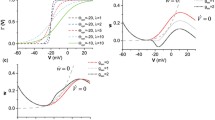Abstract
Neurons can make different responses to identical inputs. According to the emerging frequency of repetitive firing, neurons are classified into two types: type 1 and type 2 excitability. Though in mathematical simulations, minor modifications of parameters describing ionic currents can result in transitions between these two excitabilities, empirical evidence to support these theoretical possibilities is scarce. Here we report a joint theoretical and experimental study to test the hypothesis that changes in parameters describing ionic currents cause predictable transitions between the two excitabilities in mesencephalic V (Mes V) neurons. We developed a simple mathematical model of Mes V neurons. Using bifurcation analysis and model simulation, we then predicted that changes in conductance of two low-threshold currents would result in transitions between type 1 and type 2. Finally, by applying specific channel blockers, we observed the transition between two excitabilities forecast by the mathematical model.






Similar content being viewed by others
References
Del Negro, C. A., & Chandler, S. H. (1997). Physiological and theoretical analysis of K+ currents controlling discharge in neonatal rat mesencephalic trigeminal neurons. Journal of Neurophysiology, 77, 537–553.
Ermentrout, B. (1996). Type I membranes, phase resetting curves, and synchrony. Neural Computation, 8, 979–1001.
Ermentrout, B., Pascal, M., & Gutkin, B. (2001). The effects of spike frequency adaptation and negative feedback on the synchronization of neural oscillators. Neural Computation, 13, 1285–1310.
Guckenheimer, J., Harris-Warrick, R., Peck, J., & Willms, A. (1997). Bifurcation, bursting, and spike frequency adaptation. Journal of Computational Neuroscience, 4, 257–277.
Gutkin, B. S., & Ermentrout, G. B. (1998). Dynamics of membrane excitability determine interspike interval variability: A link between spike generation mechanisms and cortical spike train statistics. Neural Computation, 10, 1047–1065.
Gutkin, B. S., Ermentrout, G. B., & Reyes, A. D. (2005). Phase-response curves give the responses of neurons to transient inputs. Journal of Neurophysiology, 94, 1623–1635.
Hansel, D., Mato, G., & Meunier, C. (1995). Synchrony in excitatory neural networks. Neural Computation, 7, 307–337.
Henderson, G., Pepper, C. M., & Shefner, S. A. (1982). Electrophysiological properties of neurons contained in the locus coeruleus and mesencephalic nucleus of the trigeminal nerve in vitro. Experimental Brain Research, 45, 29–37.
Hodgkin, A. L. (1948). The local electric changes associated with repetitive action in a non-medullated axon. Journal of Physiology, 107, 165–181.
Izhikevich, E. M. (2000). Neural excitability, spiking and bursting. International Journal of Bifurcation and Chaos in Applied Sciences and Engineering, 10, 1171–1266.
Izhikevich, E. M. (2007). Dynamical systems in neuroscience: The geometry of excitability and bursting. Cambridge, MA: MIT.
Morris, C., & Lecar, H. (1981). Voltage oscillations in the barnacle giant muscle fiber. Biophysical Journal, 35, 193–213.
Prinz, A. A., Abbott, L. F., & Marder, E. (2004). The dynamic clamp comes of age. Trends in Neurosciences, 27, 218–224.
Rinzel, J., Ermentrout, B. (1998). Analysis of neural excitability and oscillations. In C. Koch, I. Segev (Eds.), Methods in neuronal modeling: From ions to networks (pp. 251–291). Cambridge, MA: MIT.
Robinson, H. P., & Harsch, A. (2002). Stages of spike time variability during neuronal responses to transient inputs. Physical Review. E, Statistical Physics, Plasmas, Fluids, and Related Interdisciplinary Topics, 66, 061902.
Robinson, H. P., & Kawai, N. (1993). Injection of digitally synthesized synaptic conductance transients to measure the integrative properties of neurons. Journal of Neuroscience Methods, 49, 157–165.
Schurr, A., West, C. A., & Rigor, B. M. (1988). Lactate-supported synaptic function in the rat hippocampal slice preparation. Science, 240, 1326–1328.
Sharp, A., O’Neil, M., Abbott, L., & Marder, E. (1993a). Dynamic clamp: Computer-generated conductances in real neurons. Journal of Neurophysiology, 69, 992–995.
Sharp, A., O’Neil, M., Abbott, L., & Marder, E. (1993b). The dynamic clamp: Artificial conductances in biological neurons. Trends in Neurosciences, 16, 389–394.
Tanaka, S., Wu, N., Hsaio, C. F., Turman Jr., J., & Chandler, S. H. (2003). Development of inward rectification and control of membrane excitability in mesencephalic V neurons. Journal of Neurophysiology, 89, 1288–1298.
Wu, N., Enomoto, A., Tanaka, S., Hsiao, C. F., Nykamp, D. Q., Izhikevich, E., et al. (2005). Persistent sodium currents in mesencephalic V neurons participate in burst generation and control of membrane excitability. Journal of Neurophysiology, 93, 2710–2722.
Wu, N., Hsiao, C. F., & Chandler, S. H. (2001). Membrane resonance and subthreshold membrane oscillations in mesencephalic V neurons: Participants in burst generation. Journal of Neuroscience, 21, 3729–3739.
Zhang, L., & Krnjevic, K. (1993). Whole-cell recording of anoxic effects on hippocampal neurons in slices. Journal of Neurophysiology, 69, 118–127.
Acknowledgments
We would like to thank John Rinzel, Bard Ermentrout, Eugene M. Izhikevich and Wu Nanping for the useful discussions. This work was supported by grants from NSFC (30530260) of China.
Author information
Authors and Affiliations
Corresponding author
Additional information
Action Editor: G. Bard Ermentrout
Rights and permissions
About this article
Cite this article
Liu, Y., Yang, J. & Hu, S. Transition between two excitabilities in mesencephalic V neurons. J Comput Neurosci 24, 95–104 (2008). https://doi.org/10.1007/s10827-007-0048-4
Received:
Revised:
Accepted:
Published:
Issue Date:
DOI: https://doi.org/10.1007/s10827-007-0048-4




